
Parametric Projectors Protecting Marine Mammals from Vessel Collisions
Edmund R. Gerstein - gerstein2@aol.com
Charles E. Schmidt College of Science,
Florida Atlantic University,
Leviathan Legacy, Inc.
Boca Raton, FL, 33486, (561) 809-9185
Laura Gerstein
Leviathan Legacy, Inc.
Boca Raton, FL, 33486
Josiah Greenewald
Florida Atlantic University,
Boca Raton, FL, 33486
Steven E. Forsythe
U.S. Naval Undersea Warfare Ctr.
Newport, RI
Popular version of paper 4aPA11
Presented Thursday Morning, May 21, 2009
157th ASA Meeting, Portland, OR
Whales and other marine mammals are vulnerable to boat, barge and ship collisions. With increased worldwide commerce and international shipping, vessel collisions with marine mammals have become a global concern. Though more commonly identified and reported in busy coastal areas, collisions are not restricted to shipping lanes or shallow water environments. A common denominator is that they all occur near the surface. Here the acoustical laws of reflection and propagation significantly limit the ability of marine mammals to hear and locate the sounds of approaching vessels. Whales, manatees and other animals cannot react to sounds that become indiscernible from ambient background noise nor can they react to sounds that never reach their ears. The problem is a major concern for the remnant population of North Atlantic right whales and other marine mammals, such as the West Indian manatee. Measurements of controlled ship passages through vertical hydrophone arrays demonstrate a confluence of propagation factors and near surface effects that obscure the sounds of approaching vessels which then pose serious detection challenges for marine mammals.
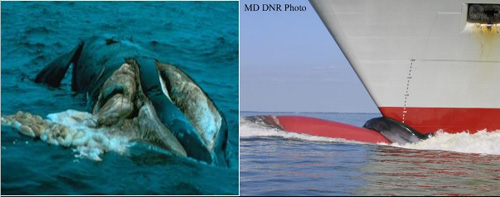 |
| Figure 1. Whales killed by ship strikes ( North Atlantic right whale cut by propeller) (Sei whale draped over the bulbous bow) |
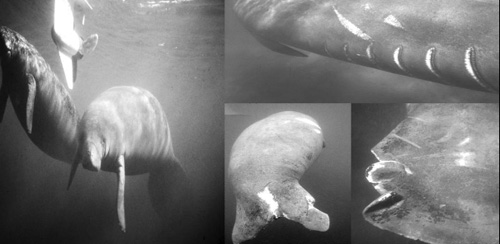 |
| Figure 2. Manatees injured by boat collisions. Most survive collisions with smaller boats, while collisions with larger slow moving barges are fatal. The incidence of collisions with small boats is so prevalent that individual manatees are routinely identified by their characteristic scars patterns from multiple encounters. Some individuals have been hit 50 different times by boats they cannot hear approaching. |
Perhaps the most confounding acoustical challenge to both whales and manatees is acoustical shadowing at the bow. It’s caused when the sound rays from a ship’s propellers are blocked from projecting forward by the ship’s hull. The majority of ships that kill whales have propeller configurations above keel depth, and this shields the sounds produced by the propellers. Ship noise with wavelengths less than the ship stern dimensions are reflected back off the stern and reflect to the sides but do not propagate forward to the bow.
Only very low frequency sounds with wavelengths larger than stern dimensions can diffract around the ship’s hull to the bow. However, near the surface, these lower frequencies are severely attenuated or canceled by a boundary interaction phenomenon known as the Lloyd’s Mirror Effect. Direct measurements reveal the confluence of acoustical shadowing, Lloyd’s Mirror Effect and spreading loss, which together make ship noise at the bow indiscernible from the ambient noise.
While the size and geometry of the shadows ahead of ships may vary with hull dimensions, propeller noise is more intense off the port and starboard sides than it is directly ahead an approaching vessel. Observations of whales surfacing in front of ships and the high incidence of strikes on North Atlantic right whale females and calves suggests that whales near the surface are unaware of ships approaching in their direct path. The acoustical conditions can confuse whales and may cause them to seek refuge by surfacing or actively swimming into the quieter zones that form directly in front of ships. Once here, hydrodynamic forces can sweep adults and especially calves into the propellers. The high incidence of collisions with calfs and females exceeds normal probability and suggests that whales may be active participants in the collision phenomenon, as they seek refuge near the surface and in front of approaching ships.
Figure 3 is a representation of the shadowing effect on the ship’s sound field. From this figure, one sees low frequency rays diffracting around the ship and the successive adjacent rays diffracting from the edges of the stern with increasing frequency until, at a high enough frequency, the last ray can be considered geometrical scattering. Directly ahead of the ship, it is relatively quiet, and whales in this path cannot detect the ship’s approach. However, off to the sides the sounds of the approaching ship can be easily heard. A movie of a cruise ship passing a hydrophone array is provided to demonstrate the acoustic shadow as the ship advances past the surface hydrophones.
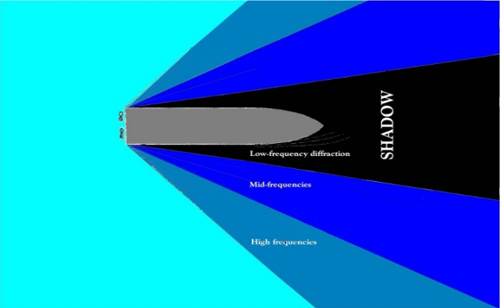
Figure 3. Schematic of acoustic shadow ahead of a ship
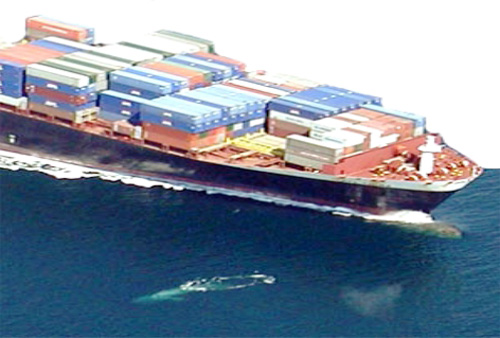
Figure 4. Near misses at the bow of a container ship
WATCH: Acoustic shadow. Click to view movie of a cruise ship passing a hydrophone array, which demonstrates the acoustical shadow. Note how you can not hear the sound of the ship until it has passed the hydrophones. If you listen carefully you can hear buoy chains rattle, but the propeller noise is absent until most of the ship passes by the hydrophone. A whale in line with the path of the ship would not have heard the ship before being struck by the bow. However, whales outside the shadow zone, to the sides, can easily hear the ship as it approaches and may actively seek refuge where it is quiet, in the shadow of death.
In an effort to reduce collisions with marine mammals, regulatory agencies have adopted vessel speed reductions. However, this strategy does not address the underlying acoustical challenges marine mammals face and can even increase collision risks. Propeller noise intensity is proportional to vessel speed, and in multiple ship environments the noise from slower vessels can be masked by the sounds of distant faster moving vessels and moderated sea states.
Recent regulations adopted to slow down ships in the whale habitats will effectively lower the frequency spectra and sound pressure levels of vessel noise. The detection of the quieter, low-frequency noise will be more precarious with respect to near surface effects and masking by the ambient noise. Ironically, reducing vessel speeds without compensating for the acoustical consequences can actually increase the risks of collisions by reducing detectability and conversely increasing transect time and the opportunities for collisions.
Current visual and developing passive acoustic monitoring coupled with slow speed regulations may help protect some whales by diverting ships from a whale’s general vicinity; however, whales don't always vocalize and this overall strategy is still reliant upon visual surveillance. At night, when whales are very active, and during moderate sea states and periods of poor visibility, these strategies offer little protection and may even increase the risk of collisions.
Blanket reduction of vessel speeds without compensating for the associated acoustical consequences and challenges of near surface propagation can be counter-productive to the protection of whales as it has for manatees. After a decade of speed regulations implemented to protect the West Indian manatee in Florida, the number of mortalities and non-lethal collisions have increased to record highs, and manatees continue to be killed each year by slow lumbering barges for which speed restrictions have no impact. Here, acoustical shadowing, limited low frequency propagation in shallow water, and near surface effects ensure manatees cannot hear many of these slow approaching vessels.
For whales, the acoustical challenges are even more serious. With much larger ships, losses from spherical spreading from the propellers to the bow, along with Lloyd’s Mirror Effect could attenuate the sounds at the bows of large slow moving ships to levels that do not satisfy the whales’ Critical Ratio necessary for auditory detection. Add acoustical shadowing to the mix, and detection is even more difficult, if not impossible, for the whales. The inconsistency of different ship and boat signatures, and the possible habituation of omnidirectional vessel noise are problems germane to both the manatees and whales.
To mitigate habituation concerns, a submerged directional array at the bows of ships has been designed to selectively fill in acoustical shadows with sounds both whales and manatees can detect. Such a device in conjunction with slower moving vessels provides marine mammals with enhanced awareness and directional cues that defeat masking. Without such a device, whales near the surface are at a sensory disadvantage and have no consistent or detectable acoustical reference with which to know of or associate the threats of approaching ships.
Joe Blue, my late partner and former Director the Underwater Sound Reference Detachment of the Naval Undersea Warfare Center and Navy Research Laboratory, who first identified these near surface acoustic challenges, conceived of a parametric acoustic alarm to mitigate these concerns. A low intensity, highly directional, dual frequency parametric array has since been developed to reduce collision risks by alerting animals in the direct path of approaching vessels. A parametric array was created to achieve a highly directional alarm with an aperture small enough so that it would result in minimal drag on the smaller boats that hit manatees. The system projector is comprised of multiple elements, band centered to transmit a high carrier frequency along with a lower side band signal. The primaries are higher than any marine mammal are presently known to hear. A single-side band modulation and phase-shift method are employed, and the nonlinearity of water demodulates the mixed high frequency carrier into a lower frequency waveform audible to both manatees and whales.
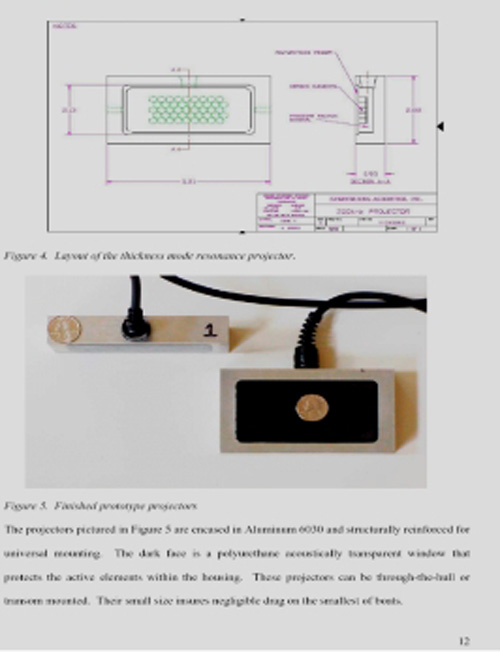 |
| Figure 5. Small parametric projectors insure negligible drag on the smallest of boats. |
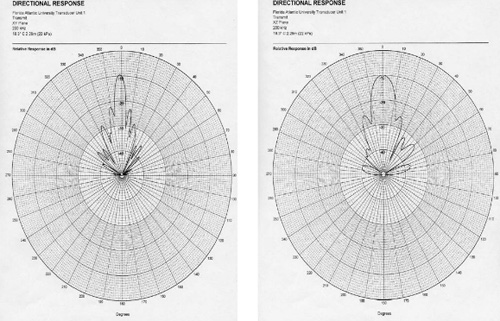 |
| Figure 6. The directional beam is only 6 degrees, which ensures only animals in the immediate path of the vessel and in imminent threat of collision are alerted, negating habituation concerns that could arise from more omnidirectional sounds. |
The bow mounted array projects a narrow beam directly ahead of vessels and “fills in” acoustical shadows to alert marine mammals of approaching danger. Controlled field tests of the manatee device in Florida's NASA wildlife refuge are proving very effective. Real-world deployments of the manatee device are planned for on select Navy and DOD vessels are planned this year and sea tests of a larger whale system will start next year.
|
Experiments conducted in a NASA security area in the Kennedy Space Center at Cape Canaveral, Florida, provided controlled environmental conditions and minimized anthrogenic acoustical variables. Thus far 100% of the alarm approaches elicited overt avoidance responses. The change in behavior during approach trials was significantly greater during alarm trials in contrast to the no alarm trials, and the distances at which manatees responded was significantly greater during alarm trials. Manatees did not respond to approaches without the alarm but responded to alarm approaches up to 35 m away at levels 18 dB above their estimated critical ratios for hearing.
Video clips of some of these trials are provided below. Click to view with Windows Media Player
WATCH: Field test without the alarm. Note how the manatee only responds when the boat is close enough to see. The boat has to veer away at the last second to avoid hitting the manatee.
WATCH: Field test of the alarm with manatee. Note how the manatee reacts and avoids the boat approaching in contrast to the test without the alarm.
WATCH: Field trial with manatee at bridge, no alarm. Note how the boat needs to veer sharply away to avoid hitting the manatee.
WATCH: Field trial of the alarm with manatee (two manatees are in this movie). Note how the one manatee exposed to the narrow projection field quickly dives and avoids the boat, while the manatee in the foreground outside the beam is unresponsive to the boat’s approach.
Funded by in part by the U.S. Department of Defense, Navy Legacy Resource Management Program, U.S. Army Corps of Engineers, Florida Inland Navigation District, Florida Fish and Wildlife Conservation Commission, Mercury Marine Corporation, Maverick Boat Company, Marine Industries Association of South Florida, and Citizens for Florida’s Waterways.